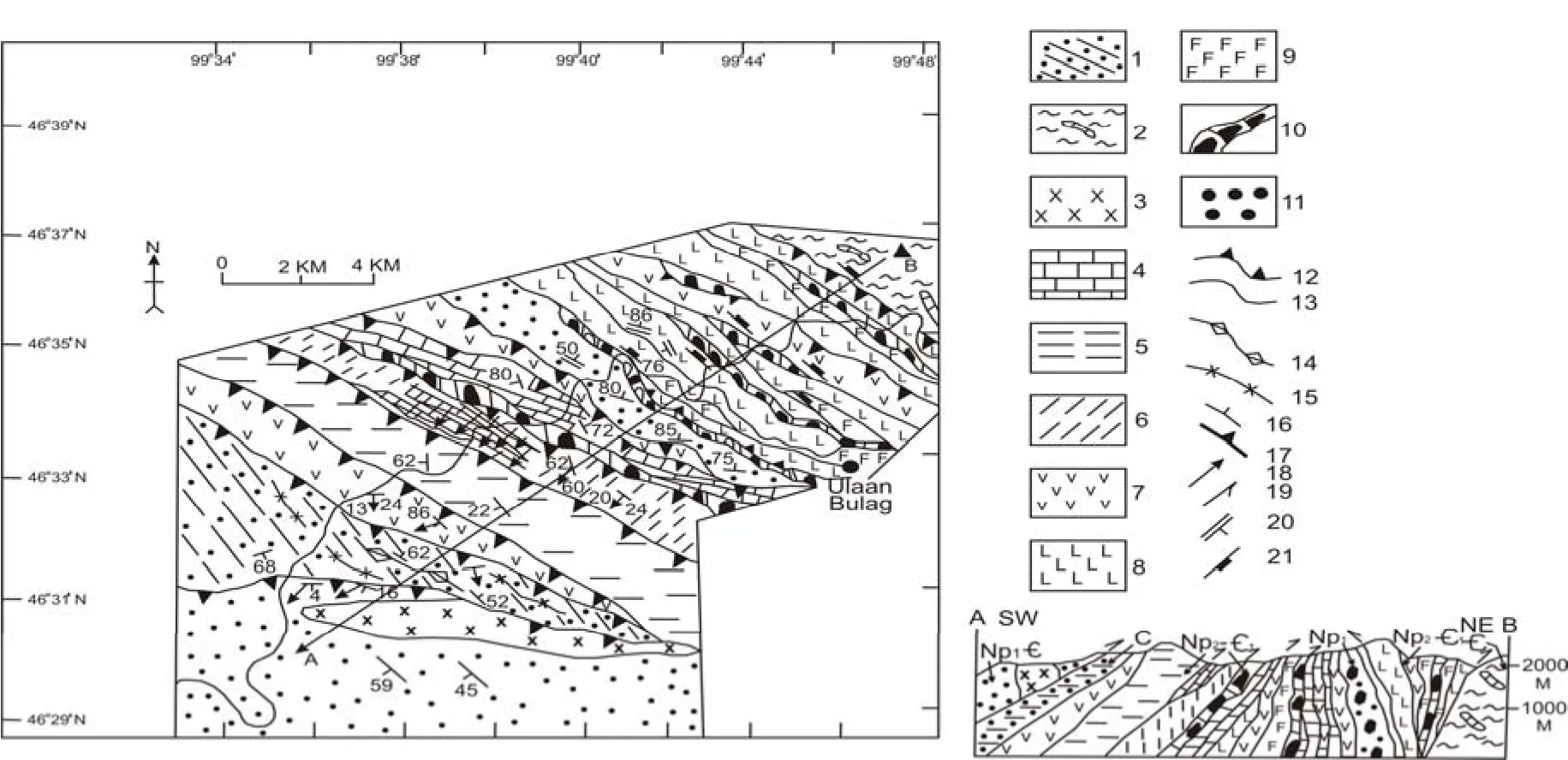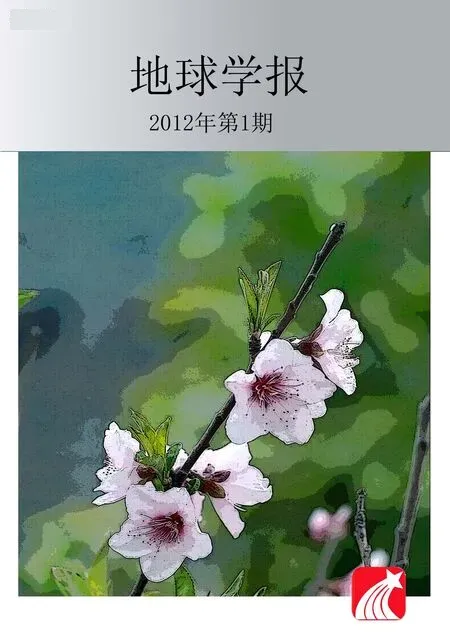蒙古中部巴彥洪古爾蛇綠巖帶烏蘭布拉格新塊狀硫化物礦床
蒙古中部巴彥洪古爾蛇綠巖帶烏蘭布拉格新塊狀硫化物礦床
E-mail: ddorj2001@yahoo.com.
0 Introduction
The Bayankhongor ophiolite zone, a NW-SE striking linear structure 400 km long and up to 25 km wide, is the largest ophiolite association in Central Mongolia and possibly in all of Central Asia. The Bayankhongor copper mineralization was investigated by us in connection with detailed research of the ophiolite complexes in 1997-2011. With regard to their origin the ore formations belong to genetic type of gold-bearing massive sulphide deposit with magmatic seat of the island arc.
1 New methods
The authors worked out and applied the method of the ore-facial analysis for volcanic massive sulphide (VMS) deposit based on petrographic, geochemical, mineralogical, geophysical researches and drilling in comparison with volcanic rocks of modern geodynamic settings.
2 New results
At the present time within the Bayankhongor ophiolite zone, about 30 copper ore occurrences are known. The zone is characterized by wide development of Neoproterozoic-Cambrian ultramafic and mafic paleooceanic complexes. In the north-west part of the zone we have found some new perspective copper ore occurrences: Ulanbulag, Oyutolgoi, Zakhbulag and Temeenkhuzuu. Among them the Ulanbulag ore field(deposit) was investigated in more detail.
According to Dorjnamjaa et al. (2003, 2009), the Ulanbulag VMS deposit was recognized for the first time in Central Mongolia. The deposit is wonderfully-preserved from erosion and active denudation,and characterized by both good natural exposures and diversity of the Neoproterozoic-Cambrian volcanogenic and sedimentary rocks. The deposit is located at the left edge of the Ulziit-gol valley, at the dry ravine mouth of the Ulanbulag. The volcanogenic rocks of the Bayankhongor Formation are widespread within the deposit area and represented by spilite, diabase and andesite with subordinate layers of siliceous and carbonaceous rocks (Fig.1). These rocks often contain doleritic dykes. The Ulanbulag faulted zone is the main ore-bearing structure, which presents numerous dyke bodies and volcanogenic rocks (Fig. 2). They are brecciated, and quartzosed, but rarely ironshoted. At present, as a result of mapping and prospecting surveys, two ore-bearing blocks are apparent. South block(Onit) is characterized by the lens of a very composite shape in the form of stockwork. North block (Artsat)presents two ore-bearing horizons.
The length of the ore zone exceeds 2 km and the width is sometimes up to 500 m. The mineralization presents breccia-form and veining, which have developed sporadically. Rocks spontaneously containing mineralization have undergone weak hydrothermal alteration: sericitization, chloritization and quartization. The horsetail ore bodies consist of intersecting and interlacing veins and impregnation ores. During 2008 the prospect holes have bored 215 metres deep and revealed ore bodies on the numerous intervals.Main ore minerals are pyrite, chalcopyrite, chalcocite and arsenopyrite. Among oxidized ores there are cuprite, turquoise, azurite, malachite, covellite, tenorite and limonite. Content of copper in primary ore is changed, as Cu 0.31%-7.1%, Au 0.11-11.9g/t, Ag 2.8-25.73g/t. They usually form a dissemination matrix of alterated basaltoid and include in quartz and quartz-sericitic veins together with other sulphides.Main industrial mineral types of the ore include copper,gold and silver-containing sulphides. Accompanying components are silver, zinc, lead, sulphur and others.In our opinion, from the point of view of their regularity in the distribution, condition of formation and also mineral association, the new Ulanbulag copper deposit can reveal nonferrous and perhaps other noble metals in the future.

Fig. 1 Structural sketch map of Mongolia BKZ-Bayankhongor zone; KKT-Khangai-Khentei trough; 1-3-Precambrian massifs: 1-Tuva-Mongolian; 2-Zavkhan; 3-Central Mongolian;4-6-Fold systems: 4-Caledonides of western Mongolia; 5-Caledonides of central and eastern Mongolia; 6-Hercynides of southern Mongolia; 7-ophiolites and ophiorags; 8-12-Ophiolite zones in brackets: 8-Khan-Khukhei(l); 9-Zavkhan(2); 10-Khantaishir(3); ll-Ikh Bogd(4); 12-Zed(5);13-the study area (Ulanbulag deposit)

Fig. 2 Geological map of the Ulziitgol transect (from Buchan and Dorjnamjaa, 1997)1-Carboniferous mudstone (with crinoids and brachiopods); 2-Cambrian greenschists and limestone; 3-Cambrian granite intrusion; 4-Fissile shale, chert and limestone 5-interbedded massive limestone and shale; 6-imbricated sedimentary units; 7-intermediate volcanics and granitic rocks; 8-Pillow basalts;9-Layered and sheeted dykes; 10-serpentinised ultrama.fics; 11-Lower Neoproterozoic guch(khukh bulag) formation; 12-Thrust; 13-Geological boundary;14-Antiform axial trace; 15-Synfom axial trace; 16-Bedding dip-igneous layering; 17-Foliation dip; I8-Lineation plunge; 19-Fold hinge plunge;20-Dyke dip; 21-Normal shear dip
3 Conclusions
The Bayankhongor ophiolite zone is the best tectonic model for gold-copper-magmatism potentially connected with accretionary terrane of backarc spreading.
The Ulanbulag VMS deposit was formed at the margins of the Paleoasian ocean. The studied structure corresponds to the backarc basin, and the volcanism and ore formation are developed in conditions of scattered spreading.
DORJNAMJAA D. 2003. A copper sulphidic ore formation of the Bayankhongor ophiolite zone in Central Mongolia. Mongolian Geoscientist: 56.
DORJNAMJAA D, AMARSAIKHAN Ts, TULGA Ts. 2009. Geologic structure, peculiarities of formation and perspective of massive sulphide in the Bayankhongor ophiolite zone, with the example of the Ulanbulag gold-copper-massive sulphide ore field. Ulaanbaatar: 117.
New Ulanbulag Massive Sulphide Deposit in the Bayankhongor Ophiolite Zone, Central Mongolia
D. DORJNAMJAA, Ts. AMARSAIKHAN, B. ENKHBAATAR, G. ALTANSHAGAI
Paleontological Center, Mongolian Academy of Sciences, Ulaanbaatar, Mongolia
massive sulphide deposit; Bayankhongor ophiolite zone; central Mongolia
10.3975/cagsb.2012.s1.06
book=11,ebook=116

